
Here we are in the month of June. It is now a year since Tradition Magazine made its debut, peeking its infantile little head out into the wide world. We’ve learned a lot in this first year. We’ve made some mistakes—more than a few—had a rather long hiatus through the fall, and seen some significant turnover on the team. But, through it all, you—our audience—have waited it out, stuck with us, and given us your support. Thank you.
I would especially like to thank our paid subscribers. Your support has allowed us to obtain quality recording equipment to provide a clear audio version of the magazine. As a thank you, we will soon be providing some material for paid subscribers only, beginning with recordings of some of Augustine’s sermons and then adding on other ancient sermons, commentaries, and even some contemporary lectures. Your continued support is appreciated as it will allow us to purchase the rights to reproduce and record more recent texts or to pay for the translation of works that are yet only available in Latin or French—a task that is simply too time consuming for our small team of volunteers.
Now, on to the current issue.
In this issue, we take a look at “Time”—the past, the present, the future—and the sanctification of time. In part 1, we review the past, beginning as is most sensible with the beginning. Our first text from Genesis is what some scholars call “the first story of creation.” Many of our standard Bible translations, such as the New American Bible, add this title as a heading for chapter 1 with “the second story of creation” indicated at chapter 2, verse 4. Many Catholic biblical scholars are moving away from this view of competing creation stories, however, and instead recognise the second story to be a zooming in on the creation of Eden. Here we present the creation of the world, the whole cosmos, of light, the dry land, vegetation, the sun, moon, and stars, birds, fishes, beasts, and finally man. At the end of each day—except the second—God sees that what he made is good. The Septuagint translates the word for “good” as kalon, “beautiful.” God considers creation to be beautiful, to be good to behold, and He delights in what He has made.
Next we take a passage from one of Augustine’s many commentaries on Genesis. In this passage he reflects on the seven days of creation and identifies each day as an allegory for one of the seven stages of man’s life and for one of the seven ages of the world. The creation begins the world’s infancy and it grows and develops into childhood at the time of Noah, through adolescence at the time of Abraham, into the glory of youth in the time of the Davidic kingdom. The Babylonian exile marks the entry of the world into the wisdom of an elder, while the coming of Christ brings full maturity in old age. The seventh day, the day of the world’s rest is yet to come, the day when we will rest with Christ in the true Eden.
Continuing with the Augustinian thread, Anastasia Cherygova’s article on book X of the Confessions deals with the problem of memory. What is it? How can it take the past—what is no more—and make it present to the mind? She shows how book X, while often considered disjointed from the first nine books and certainly more difficult to follow, is really fundamental for understanding what Augustine is doing throughout the work, that is, making the past present.
We then move to a historical thread, beginning with Bede’s preface to his Ecclesiastical History of the English People. Here we consider the purpose of reading history, namely to learn to imitate the good deeds and avoid the evil deeds of those who came before us. Angelica Medina reflects on the “Black Legend,” the rather biased narrative of the Spanish colonial era; she argues that we need to take another look at the stories we tell about the actions of Catholic Spain in the New World. Finally, as though in reply to Angelica, Wade Loach presents an account of Fr. John Lingard, the founder of the modern historical method—a method that he meant to be unbiased and objective. Certainly Fr. Lingard’s method has something to offer as we look back at the early days of New Spain.
This takes us to the end of part 1, the end of the past. The next part of this issue will present the present, but that will have to wait until next week. For now we must be content with the past.
Aaron P. Debusschere
Editor

Leave a Reply